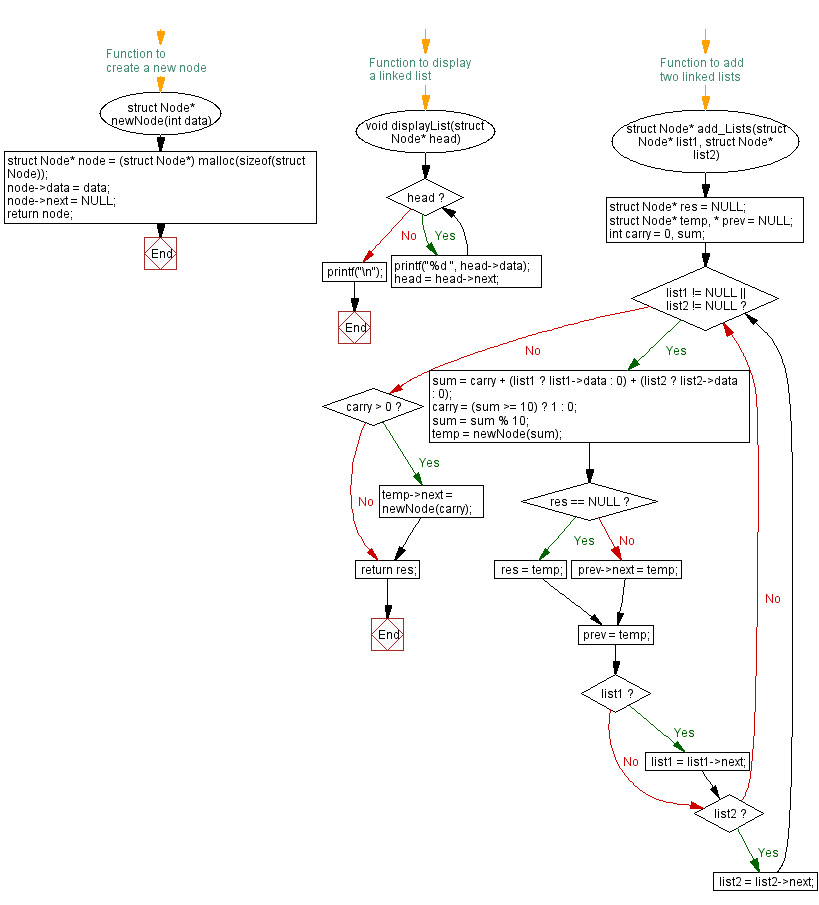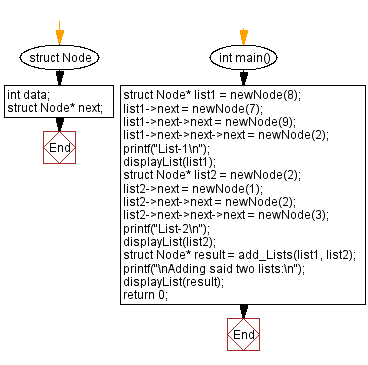C Exercises: Add two numbers represented by linked lists
22. Linked List Addition Variants
Write a C program that takes two linked lists of numbers. Each node contains a single digit and returns the sum of those numbers of said linked lists as a linked list.
Sample Solution:
C Code:
#include<stdio.h>
#include <stdlib.h>
// Define a structure for a Node in a singly linked list
struct Node {
int data;
struct Node* next;
};
// Function to create a new node with given data
struct Node* newNode(int data) {
// Allocate memory for a new node
struct Node* node = (struct Node*) malloc(sizeof(struct Node));
// Set the data for the new node
node->data = data;
// Set the next pointer of the new node to NULL
node->next = NULL;
return node;
}
// Function to display the elements of a linked list
void displayList(struct Node* head) {
while (head) {
printf("%d ", head->data);
head = head->next;
}
printf("\n");
}
// Function to add two linked lists
struct Node* add_Lists(struct Node* list1, struct Node* list2) {
struct Node* res = NULL;
struct Node* temp, * prev = NULL;
int carry = 0, sum;
// Traverse both lists and perform addition
while (list1 != NULL || list2 != NULL) {
sum = carry + (list1 ? list1->data : 0) + (list2 ? list2->data : 0);
// Calculate carry for next calculation
carry = (sum >= 10) ? 1 : 0;
sum = sum % 10;
// Create a new node with the sum as data
temp = newNode(sum);
// If the result list is empty, set the result as the new node
if (res == NULL)
res = temp;
else
prev->next = temp;
prev = temp;
// Move to the next nodes in the lists
if (list1) list1 = list1->next;
if (list2) list2 = list2->next;
}
// If there is a remaining carry, add a new node to the result
if (carry > 0)
temp->next = newNode(carry);
return res; // Return the head of the resulting list
}
// Main function where the execution starts
int main() {
// Creating two linked lists
struct Node* list1 = newNode(8);
list1->next = newNode(7);
list1->next->next = newNode(9);
list1->next->next->next = newNode(2);
printf("List-1\n");
displayList(list1); // Display the first list
struct Node* list2 = newNode(2);
list2->next = newNode(1);
list2->next->next = newNode(2);
list2->next->next->next = newNode(3);
printf("List-2\n");
displayList(list2); // Display the second list
// Add the two lists
struct Node* result = add_Lists(list1, list2);
printf("\nAdding said two lists:\n");
displayList(result); // Display the result of addition
return 0; // Indicates successful completion of the program
}
Sample Output:
List-1 8 7 9 2 List-2 2 1 2 3 Adding said two lists: 0 9 1 6
Flowchart :


For more Practice: Solve these Related Problems:
- Write a C program to add two numbers represented by linked lists where digits are stored in reverse order without reversing the lists.
- Write a C program to add two numbers represented by linked lists with digits stored in forward order.
- Write a C program to add two linked list numbers of unequal lengths handling carry propagation correctly.
- Write a C program to subtract one number from another when both are represented as linked lists with borrow handling.
Go to:
PREV : Partitioning with Dual Pivots.
NEXT : List Rotation Challenges.
C Programming Code Editor:
Have another way to solve this solution? Contribute your code (and comments) through Disqus.
What is the difficulty level of this exercise?
